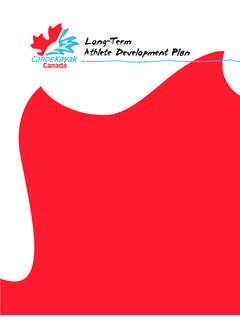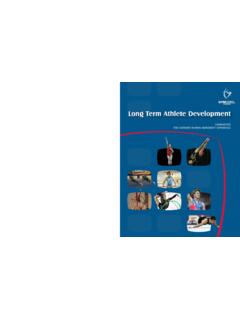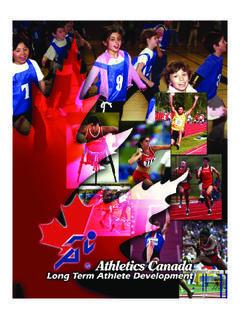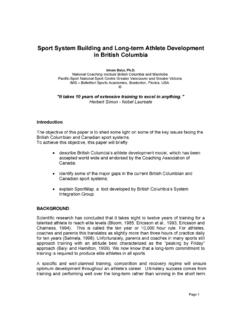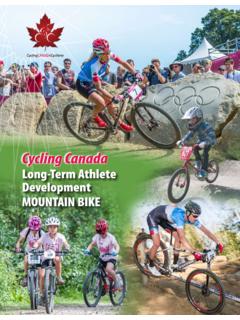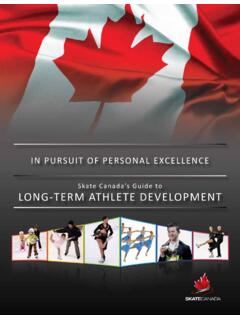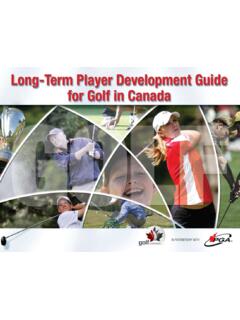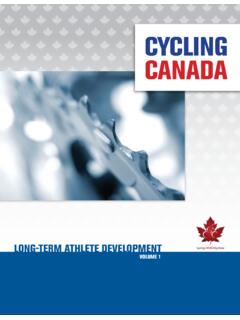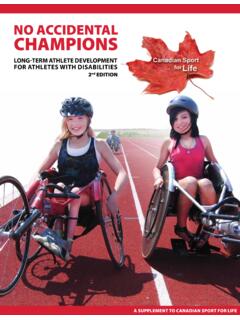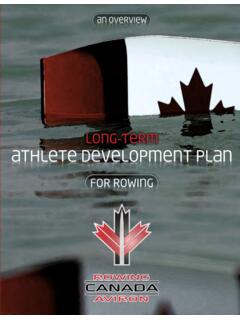Transcription of Long-Term Athlete Development - Broomball
1 Long-Term Athlete DevelopmentBroomball Canada1 The Canadian Broomball Federation (CBF) gratefully acknowledges the contributions of the following individuals in the Development of the Canadian Sport for Life (CS4L) document, that encompasses a Long-Term Player Development Brown (ON)Cathy Derewianchuk (MB)Genevi ve Hardy (QC)Scott Jul (SK)Georgina Reynolds (ON)Carolyn Trono (Project Writer)Richard Way (LTAD Expert)A special thank you to Pascale Gauthier for the matrix developed for this document. Thank you to Danielle Bell for her work on analyzing the data from the surveys and working on various diagrams in the document. The Canadian Broomball Federation would also like to thank the Provincial/Territorial representatives who attended the 2008 CBF Annual General Meeting.
2 These representatives provided ideas and input into the strategic initiatives as a result of the workshop on Vallillee (Northwest Territories)Brian Gouthreau (Alberta)Gord Wilson (Alberta)Greg Perreaux (Saskatchewan)Don Black (Saskatchewan)Don Gray (Saskatchewan)John Hogg (Manitoba)Alan Park (Manitoba)Gerry Wever (Ontario)Marilyn Squibb (Ontario)Harold Clarke (Newfoundland)Andre Labelle (Quebec)Daniel Brunet (Quebec)Rob McKellar (Nova Scotia)Photo Credits:Claude Lapr s (Photo-Sport)Cov (left), pg 8, pg 21 (right top), pg 26 All remaining photos courtesy Rick PrzybyszACKNOWLEDGMENTSAll rights reserved. No part of this work may be reproduced or transmitted in any form for commercial purposes, or by any means, electronic or mechanical, including photocopying and recording or from any information stored in a retrieval system, without permission from the authors or The Canadian Broomball Canadian Broomball Federation, 2009 ISBN # 978-0-9695788-2-6 We acknowledge the fi nancial support of the Government of Canada through Sport Canada, a branch of the Department of Canadian Heritage.
3 Broomball Canada2 Broomball Canada3 FOREWORDTABLE OF CONTENTSMany elements need to be in place to achieve ongoing success with the national/international Broomball programs and to maximize the contribution that the sport of Broomball can make to improve the health and well-being of Canadian society. The Long-Term Athlete Development (LTAD) model has been developed to ensure Canadians have a clear understanding of the eight (8) stages of Development and provides the reader with information on the key components of the Broomball sport system. These components are seamlessly integrated into the model to help achieve the above objectives.
4 The timing to collectively build this model could not have been better. Broomball in Canada is thriving. There is a steady growth in Broomball through the country. National, provincial, community and club leaders have partnered to build Long-Term strategic plans and the level of cooperation among these leaders has reached historic highs, with a clear understanding of roles and responsibilities of many involved. The elite and community programs have been rejuvenated with National Coaching Certifi cate Program (NCCP) Certifi ed Broomball Coaches, and the establishment of a National Youth Coordinator. These two components and a strengthened volunteer base enhances the strong team currently in place to create a culture of excellence for Broomball Development .
5 Progressive Broomball is a terrifi c tool to introduce new participants and young children in a systematic way using age/skill appropriate modifi ed teaching systems. At the grassroots level, the strategy of developing Provincial/Territorial partnerships to ensure Broomball is meeting and addressing community needs has also proved to be a successful and cutting edge approach to grow the game. This model is a direct outcome of years of work and collaboration with partners, community leaders and volunteers. Existing and newly formed program along with continuous research were used to develop this framework/model. Special thanks to our Board of Directors, Provincial/Territorial Association partners, LTAD steering committee members, sponsors, donors, volunteers, community champions, supporters, players and all those who contributed to building this very important model many recognized in the acknowledgment section.
6 Special thanks are in order to George Brown CBF VP Technical for his superb work as project leader. Your ongoing support and contribution inspires us as we collectively build a world class system. Delivering well-thought out, effective programs that are adaptable to the diversity within Canadian communities will increase the odds of producing future National champions and ensuring Canadians enjoy the sport of Broomball for life. The conditions are ripe to achieve our vision of being among the leading sports and recreational activity nationally and to consistently rank among the world s top Broomball nations. Yours in Broomball ,Rick PrzybyszPresidentCanadian Broomball FederationOVERVIEW 4 THE 10 KEY FACTORS 8 CBF s 5 STAGE APPROACH 15 Broomball Long-Term Development MODEL (BLTD)
7 16 LEARNING AND Development CONTINUUM 17 CBF SKILLS MATRIX 18 CBF s STAGES 23 THE FUTURE OF CBF 30 GLOSSARY 32 REFERENCES 34 APPENDIX 1 36 APPENDIX 2 38 Broomball Canada4 Broomball Canada5 OVERVIEWCS4L is a framework that encompasses the participation of a whole population in sport from infants to seniors. CS4L can be divided into three broad areas: Physical Literacy, Active for Life and Excellence. In this idealized model, all children become physically literate, which lays the foundation for later sport excellence or being active for life.
8 This model also shows where athletes pursuing excellence ultimately transition into Active for Life through competitive sport or active Literacy is the priority focus at the Active Start stage and continues to be a priority throughout the FUNdamentals and Learning to Train stages, addressing the Development of basic movement and sport skill in children, before their growth spurt. CS4L highlights the need for all children to be physically for Life is sport for life: life- long participation in sport and physical activity from adolescence to seniors, for health, social and enjoyment benefi ts. That range allows all Canadians to be physically active through competitive sport and recreation participation.
9 Excellence includes the Training to Train, Training to Compete, and Training to Win stages, which is the pathway for athletes to national and international success. Figure 1 Canadian Sport for Life (Way et al, 2005)OVERVIEWWHAT IS Long-Term Athlete Development ?CS4L outlines the LTAD framework for sport Development which includes a stage by stage approach for individuals participating in sport for health, fi tness and fun as well as for high performance sport. Canadian Sport for Life Is a Made in Canada approach to Athlete Development that acknowledges the importance of individual sport culture as well as the Canadian political and social factors that infl uence Athlete Development .
10 It recognizes best practices in elite sport and what normative data and research tells us about Long-Term Athlete Development . Contributes to and promotes a healthy, physically literate nation whose citizens participate in lifelong physical activity. Recognizes the need to involve all Canadians in the LTAD process, including athletes with a disability. Is an eight-stage model* based on the physical, technical, mental, emotional and cognitive Development of sport participants. The overarching premise of LTAD is the Active for Life stage encouraging life- long physical activity. Provides ten important factors that shape the sport-specifi c LTAD model for a logical and healthy approach to Athlete Development .
